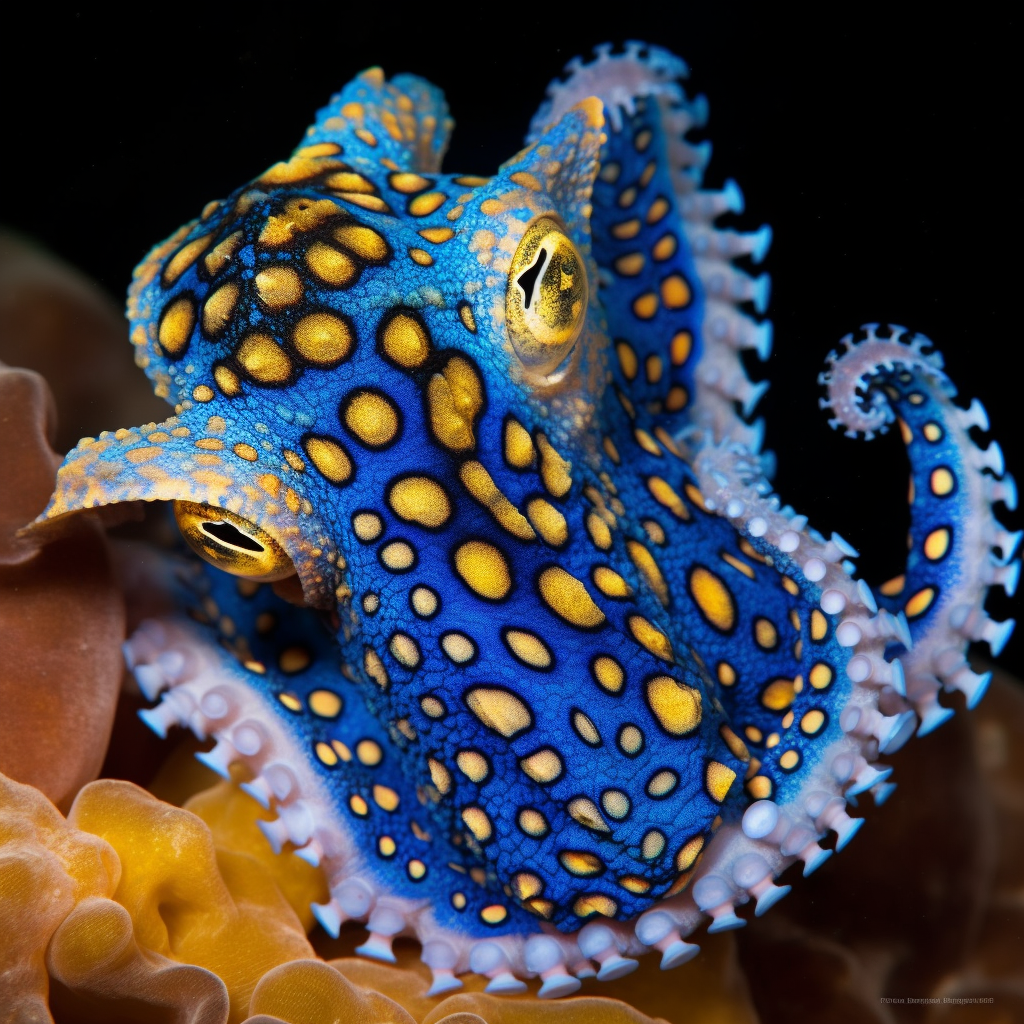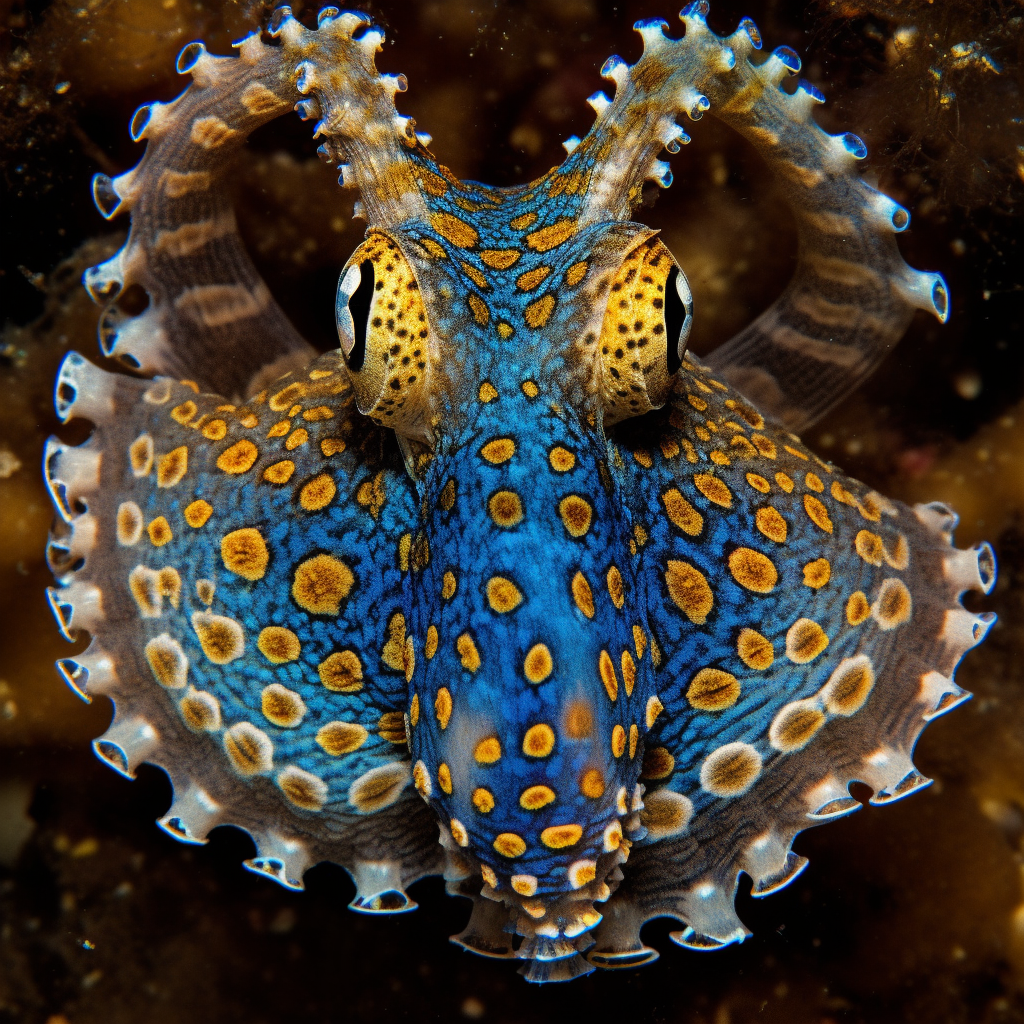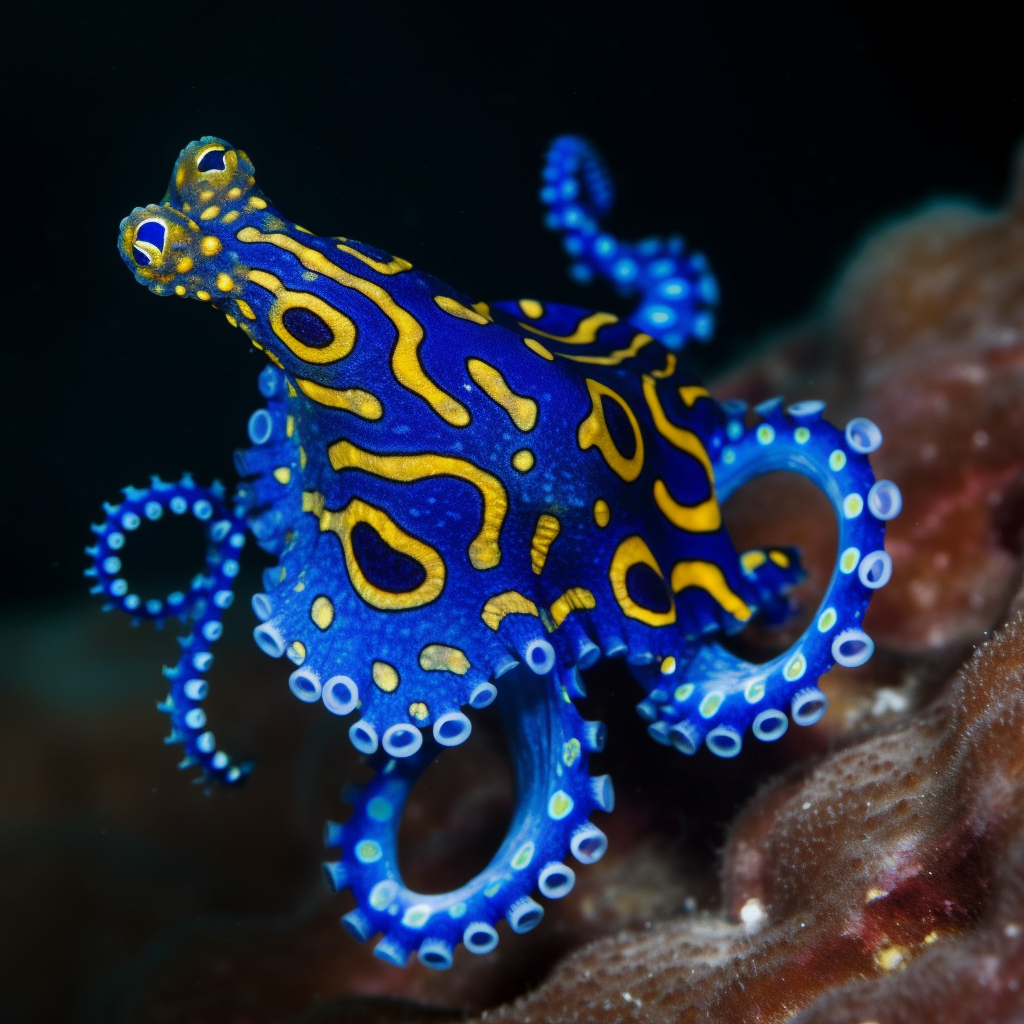The blue-ringed octopus is a fascinating creature known for its vibrant blue rings and deadly venom. Despite its small size, this tiny cephalopod is one of the most venomous marine animals in the world. In this article, we will explore the size range of the blue-ringed octopus and delve into its intriguing characteristics. From its miniature stature to its potent venom, there is much to discover about this captivating creature. So, let’s dive in and learn just how big the blue-ringed octopus can get.
Key Takeaways
- Blue-ringed octopuses are small creatures, typically growing to a size of only 12 to 20 centimeters.
- Despite their small size, blue-ringed octopuses are highly venomous and can be dangerous to humans.
- These octopuses are known for their vibrant blue rings, which they display as a warning signal when threatened.
- Blue-ringed octopuses are found in the Pacific and Indian Oceans, primarily in shallow coastal waters and tide pools.
Unveiling the Blue Ringed Octopus: A Brief Overview
A. The Unique Characteristics of the Blue Ringed Octopus
The blue-ringed octopus is a fascinating creature that captivates the imagination of marine enthusiasts and scientists alike. Despite its small size, this cephalopod possesses a range of unique characteristics that set it apart from other species.
-
Vibrant Blue Rings: One of the most striking features of the blue-ringed octopus is its vibrant blue rings. These rings serve as a warning sign to potential predators, indicating that the octopus is highly venomous. When threatened or agitated, the blue rings become even more pronounced, acting as a visual deterrent.
-
Venomous Bite: Despite its diminutive size, the blue-ringed octopus is one of the most venomous creatures in the ocean. Its venom contains tetrodotoxin, a potent neurotoxin that can cause paralysis and even death in its prey. This venom is produced by bacteria in the octopus’s salivary glands and is used primarily for hunting.
-
Camouflage Expert: The blue-ringed octopus is a master of disguise. It possesses the ability to change its skin color and texture, allowing it to blend seamlessly with its surroundings. This camouflage technique helps the octopus to hide from predators and ambush unsuspecting prey.
-
Intelligence and Problem-Solving Skills: Octopuses, including the blue-ringed octopus, are known for their high level of intelligence. They have complex nervous systems and exhibit problem-solving skills that rival those of some mammals. This intelligence allows them to navigate their environment, find food, and even escape from enclosures.
B. The Habitat and Distribution of the Blue Ringed Octopus
The blue-ringed octopus can be found in the warm waters of the Pacific and Indian Oceans, particularly in the coastal regions of Australia, Indonesia, and the Philippines. These cephalopods prefer shallow, sandy or rocky habitats, often near coral reefs or seagrass beds.
-
Coastal Waters: Blue-ringed octopuses are primarily found in coastal waters, typically at depths ranging from 0 to 20 meters. They prefer areas with ample hiding spots, such as crevices, shells, or coral formations, where they can seek shelter during the day.
-
Tropical and Subtropical Regions: These octopuses thrive in tropical and subtropical regions due to the warm water temperatures and abundant food sources. The nutrient-rich waters near coral reefs provide an ideal habitat for the blue-ringed octopus and its prey.
-
Nocturnal Behavior: Blue-ringed octopuses are primarily nocturnal creatures, meaning they are most active during the night. They venture out of their hiding spots under the cover of darkness to hunt for small crustaceans, fish, and other invertebrates.
-
Limited Distribution: While the blue-ringed octopus is a fascinating creature, it has a relatively limited distribution compared to other octopus species. Its preference for specific habitats and warm waters restricts its range to certain regions of the Pacific and Indian Oceans.
In conclusion, the blue-ringed octopus is a small but remarkable creature with unique characteristics that make it stand out in the marine world. Its vibrant blue rings, venomous bite, camouflage abilities, and intelligence contribute to its survival in its coastal habitat. Understanding the habitat and distribution of the blue-ringed octopus helps shed light on its fascinating life and the importance of preserving its fragile ecosystem.
The Size of the Blue Ringed Octopus: A Detailed Examination

The blue-ringed octopus is a fascinating creature that inhabits the waters of the Pacific and Indian Oceans. Known for its vibrant blue rings and venomous bite, this small cephalopod has captured the curiosity of marine enthusiasts and scientists alike. In this section, we will delve into the size of the blue-ringed octopus, exploring its typical dimensions, the largest recorded specimens, and the factors that influence their size.
A. The Typical Size of a Blue Ringed Octopus
The blue-ringed octopus is generally considered to be a small species, with an average size ranging from 12 to 20 centimeters (4.7 to 7.9 inches) in length. However, it’s important to note that size can vary among individuals and geographic locations. Some specimens may be slightly smaller or larger than the average.
Despite its modest size, the blue-ringed octopus possesses a remarkable ability to camouflage itself, blending seamlessly with its surroundings. This makes it a formidable predator, capable of surprising its prey with lightning-fast strikes.
B. The Largest Recorded Blue Ringed Octopus
While the blue-ringed octopus is typically small, there have been reports of larger individuals. The largest recorded blue-ringed octopus measured around 30 centimeters (11.8 inches) in length. This exceptional specimen was discovered off the coast of Australia, where these creatures are commonly found.
It’s worth mentioning that finding such large blue-ringed octopuses is relatively rare. Most individuals encountered by divers and researchers are considerably smaller. Nonetheless, the existence of larger specimens highlights the potential for size variation within this species.
C. Factors Influencing the Size of Blue Ringed Octopuses
Several factors can influence the size of blue-ringed octopuses. One of the primary factors is their habitat and available food sources. Blue-ringed octopuses inhabit a variety of coastal environments, including coral reefs, rocky shores, and sandy bottoms. The abundance and availability of prey in these habitats can impact the growth and size of these cephalopods.
Another factor that influences the size of blue-ringed octopuses is their age and reproductive cycle. Like other octopus species, blue-ringed octopuses have a relatively short lifespan, typically ranging from one to two years. During their short lives, they undergo rapid growth and development, reaching sexual maturity within months. The size at which they reach maturity can vary, with some individuals maturing at smaller sizes than others.
Additionally, genetic factors may also play a role in determining the size of blue-ringed octopuses. Genetic variations within a population can lead to differences in growth rates and overall size. This genetic diversity contributes to the overall resilience and adaptability of the species.
In conclusion, the blue-ringed octopus is a small but captivating creature. While the typical size of these cephalopods ranges from 12 to 20 centimeters (4.7 to 7.9 inches), larger individuals measuring up to 30 centimeters (11.8 inches) have been recorded. The size of blue-ringed octopuses can be influenced by various factors, including habitat, food availability, age, reproductive cycle, and genetic variations. Understanding these factors helps us gain a deeper appreciation for the fascinating world of these enigmatic creatures.
The Venomous Nature of the Blue Ringed Octopus
The Blue Ringed Octopus is a fascinating creature known for its vibrant blue rings and venomous nature. Despite its small size, this octopus is one of the most venomous marine animals in the world. In this section, we will explore how Blue Ringed Octopuses produce their venom and the potency and effects of their venom.
A. How Blue Ringed Octopuses Produce Their Venom
Blue Ringed Octopuses have specialized glands called salivary glands, which are responsible for producing their venom. These glands are located in the octopus’s mouth and are connected to a venom sac. When the octopus feels threatened or wants to capture prey, it releases venom through its beak.
The venom of the Blue Ringed Octopus contains a potent neurotoxin called tetrodotoxin. This toxin is also found in other marine animals, such as pufferfish, and is known for its ability to paralyze the nervous system. Interestingly, Blue Ringed Octopuses do not produce tetrodotoxin themselves. Instead, they obtain it from bacteria present in their environment, particularly in the food they consume.
B. The Potency and Effects of the Blue Ringed Octopus Venom
The venom of the Blue Ringed Octopus is incredibly potent, and even a small amount can be lethal to humans. The neurotoxin tetrodotoxin targets the nervous system, blocking the transmission of nerve impulses. This leads to paralysis, which can affect breathing and ultimately result in death if not treated promptly.
When a Blue Ringed Octopus injects its venom into its prey or a potential threat, the effects are swift and severe. The venom causes muscle weakness, numbness, and respiratory distress. Victims may experience difficulty breathing, loss of coordination, and even complete paralysis. It is crucial to seek immediate medical attention if bitten or stung by a Blue Ringed Octopus.
It is important to note that the venom of the Blue Ringed Octopus is primarily used for hunting and defense. These octopuses are generally not aggressive towards humans unless provoked. However, it is essential to exercise caution and avoid contact with these creatures to prevent any potential harm.
In conclusion, the Blue Ringed Octopus possesses a venomous nature due to the potent neurotoxin tetrodotoxin found in its venom. The production of this venom occurs through specialized salivary glands, and its effects can be severe, leading to paralysis and potentially death. Understanding the venomous nature of the Blue Ringed Octopus highlights the importance of respecting these creatures and avoiding any unnecessary interactions.
The Predators of the Blue Ringed Octopus: A Survival Story

The blue-ringed octopus may be small in size, but it is not without its fair share of predators. In the vast ocean, where survival is a constant battle, these fascinating creatures have developed some remarkable defense mechanisms to protect themselves. Let’s take a closer look at the common predators of the blue-ringed octopus and the defense mechanisms they employ.
A. Common Predators of the Blue Ringed Octopus
Despite its venomous bite, the blue-ringed octopus is not invincible. There are several predators in the ocean that pose a threat to these tiny cephalopods. Some of the common predators include:
-
Moray Eels: These elongated, snake-like creatures are known for their sharp teeth and voracious appetite. Moray eels are skilled hunters and have been observed preying on blue-ringed octopuses.
-
Triggerfish: Triggerfish are known for their powerful jaws and ability to crush hard-shelled prey. They have been observed attacking and consuming blue-ringed octopuses, taking advantage of their small size.
-
Tuna: These fast-swimming predators are known to feed on a variety of marine life, including small cephalopods like the blue-ringed octopus. With their speed and agility, tuna can easily catch these tiny creatures.
-
Sharks: While sharks primarily feed on larger prey, they have been known to consume blue-ringed octopuses when the opportunity arises. Sharks have a keen sense of smell and can detect the presence of these cephalopods.
B. Defense Mechanisms of the Blue Ringed Octopus
To survive in the face of such formidable predators, the blue-ringed octopus has evolved a range of defense mechanisms. These mechanisms allow them to ward off potential threats and increase their chances of survival. Here are some of the fascinating defense mechanisms employed by the blue-ringed octopus:
-
Venomous Bite: The blue-ringed octopus possesses a potent venom that contains tetrodotoxin, a neurotoxin that can paralyze and kill its prey. When threatened, the octopus may deliver a venomous bite to deter predators.
-
Camouflage: One of the most remarkable features of the blue-ringed octopus is its ability to change color and texture to blend in with its surroundings. This camouflage helps them avoid detection by predators and increases their chances of survival.
-
Ink Release: Similar to other octopus species, the blue-ringed octopus can release a cloud of ink when threatened. This ink cloud acts as a smokescreen, temporarily confusing predators and allowing the octopus to escape.
-
Arm Autotomy: In dire situations, the blue-ringed octopus has the ability to detach one of its arms as a distraction for predators. This self-amputation allows the octopus to escape while the predator is focused on the detached arm.
In conclusion, the blue-ringed octopus may be small, but it has evolved an impressive array of defense mechanisms to protect itself from predators. From its venomous bite to its remarkable camouflage abilities, these adaptations help ensure the survival of this fascinating creature in the vast and dangerous ocean. Understanding the predators and defense mechanisms of the blue-ringed octopus provides us with a glimpse into the intricate web of life beneath the waves.
The Speed and Agility of the Blue Ringed Octopus
The blue ringed octopus is not only known for its vibrant colors and venomous bite, but also for its impressive speed and agility in the water. Let’s take a closer look at how fast these fascinating creatures can move and the role that speed plays in their survival strategy.
A. How Fast Can a Blue Ringed Octopus Move?
When it comes to speed, the blue ringed octopus is no slouch. Despite its small size, this cephalopod can move with surprising quickness. While exact measurements of their speed are difficult to determine, they are known to be swift swimmers, capable of darting through the water with ease.
The blue ringed octopus achieves its speed through a combination of techniques. It propels itself forward by expelling water through a funnel-like structure called a siphon. By rapidly contracting and expanding its mantle, the octopus creates a jet of water that propels it forward. This method of locomotion allows the blue ringed octopus to move rapidly and efficiently, enabling it to navigate its environment with agility.
B. The Role of Speed in the Octopus’s Survival Strategy
Speed plays a crucial role in the blue ringed octopus’s survival strategy. As a small and venomous creature, it relies on its agility to evade predators and capture prey. By swiftly maneuvering through the water, the octopus can outmaneuver larger predators and escape potential danger.
In addition to evading predators, speed also aids the blue ringed octopus in hunting. These cephalopods are skilled hunters, using their speed and agility to catch small fish, crustaceans, and other prey. By quickly closing in on their targets, they are able to surprise and capture their meals before they have a chance to escape.
The blue ringed octopus‘s ability to move swiftly also allows it to explore its surroundings and find suitable habitats. They can navigate through coral reefs, rocky crevices, and other underwater structures with ease, searching for shelter and food.
In conclusion, the blue ringed octopus may be small in size, but it compensates with its impressive speed and agility. These characteristics enable it to survive in its marine environment, evading predators and capturing prey. By utilizing its jet propulsion system and swift movements, the blue ringed octopus showcases its remarkable abilities in the underwater world.
The Legalities and Ethics of Owning a Blue Ringed Octopus

A. Can You Legally Purchase a Blue Ringed Octopus?
When it comes to owning a blue-ringed octopus, there are legal considerations that potential owners need to be aware of. Due to their venomous nature and protected status, the sale and ownership of blue-ringed octopuses are regulated in many countries.
In the United States, for example, it is illegal to possess a blue-ringed octopus without the necessary permits. These permits are typically only granted to licensed researchers, public aquariums, and zoos. This is because blue-ringed octopuses are highly venomous and can pose a significant risk to human health if mishandled.
Similarly, in Australia, where blue-ringed octopuses are native, it is illegal to collect or possess them without the appropriate permits. The Australian government has strict regulations in place to protect these unique creatures and their fragile marine habitats.
It is important to note that even if it is legal to purchase a blue-ringed octopus in your country, it is crucial to consider the ethical implications of owning one.
B. The Ethical Considerations of Owning a Blue Ringed Octopus
While the idea of owning a blue-ringed octopus may seem intriguing, it is essential to consider the ethical implications of keeping one as a pet. Blue-ringed octopuses are delicate creatures that require specialized care and environments to thrive.
-
Habitat Requirements: Blue-ringed octopuses are marine animals that require a specific aquatic environment to survive. They need a well-maintained saltwater tank with appropriate water parameters, such as temperature, salinity, and pH levels. Creating and maintaining such an environment can be challenging and expensive.
-
Feeding and Enrichment: Blue-ringed octopuses have specific dietary needs and require a varied diet of live prey, such as small crustaceans and mollusks. Providing a suitable and diverse food source can be time-consuming and may involve sourcing live prey regularly. Additionally, blue-ringed octopuses are intelligent creatures that require mental stimulation and enrichment to prevent boredom and promote their well-being.
-
Expertise and Experience: Caring for a blue-ringed octopus requires a high level of expertise and experience. These creatures are not recommended for beginner aquarists due to their unique needs and potential dangers associated with their venomous bites. It is crucial to have a thorough understanding of their behavior, health concerns, and proper handling techniques to ensure their well-being.
-
Conservation and Sustainability: Blue-ringed octopuses are not bred in captivity, and most available specimens in the pet trade are collected from the wild. This practice can have negative impacts on wild populations and their habitats. By purchasing a blue-ringed octopus, you may inadvertently contribute to the depletion of these fascinating creatures in their natural environment.
Considering these ethical considerations, it is important to think carefully before deciding to own a blue-ringed octopus. It is crucial to ensure that you have the necessary knowledge, resources, and commitment to provide the best possible care for these unique marine animals.
Conclusion
In conclusion, the blue-ringed octopus is a fascinating and unique creature that is known for its small size but deadly venom. Despite its diminutive size, reaching only about the size of a golf ball, the blue-ringed octopus possesses one of the most potent toxins in the animal kingdom. Its vibrant blue rings serve as a warning to potential predators, signaling its venomous nature. While it may be small, the blue-ringed octopus is a powerful and dangerous predator in its own right. Its ability to camouflage itself and deliver a venomous bite makes it a formidable creature in the underwater world. As we continue to explore the depths of the ocean, it is important to appreciate and respect the incredible diversity and adaptability of creatures like the blue-ringed octopus.
Frequently Asked Questions
How big do blue ringed octopus get?
Blue ringed octopuses are quite small, with an average size of 12 to 20 cm (5 to 8 inches) including their arms. The body itself is usually no more than 5 cm (2 inches) wide.
How do blue ringed octopus get their venom?
Blue ringed octopuses produce their venom through salivary glands located in their lower beak. The venom is a powerful neurotoxin that is used for hunting prey and self-defense.
What do blue ringed octopus get eaten by?
Blue ringed octopuses have few natural predators due to their potent venom. However, they can be preyed upon by larger fish, seabirds, and occasionally other octopuses.
How long is a blue ringed octopus?
A blue ringed octopus, including its arms, can reach a length of up to 20 cm (8 inches). However, they are typically smaller, averaging around 12 to 15 cm (5 to 6 inches).
How fast is a blue ringed octopus?
Blue ringed octopuses are not particularly fast swimmers. They typically move at a slow pace, using their arms and body to crawl along the seafloor.
How big is a blue-ringed octopus?
A blue-ringed octopus typically measures between 12 to 20 cm (5 to 8 inches) in length, including its arms. The body itself is usually no larger than 5 cm (2 inches) in diameter.
Can you buy a blue ringed octopus?
It is generally not recommended to buy a blue ringed octopus as a pet due to their highly venomous nature. In many places, it is also illegal to own one without a special permit.
How big do blue ringed octopus grow?
Blue ringed octopuses typically grow to a size of 12 to 20 cm (5 to 8 inches) including their arms. They reach their full size within their short lifespan of approximately two years.
Can you own a blue ringed octopus?
Owning a blue ringed octopus is generally discouraged due to their highly venomous nature. In many jurisdictions, it is also illegal to own one without a special permit.
How big does a blue ringed octopus get?
Blue ringed octopuses can reach a size of 12 to 20 cm (5 to 8 inches) including their arms. The body itself is usually no larger than 5 cm (2 inches) in diameter.




